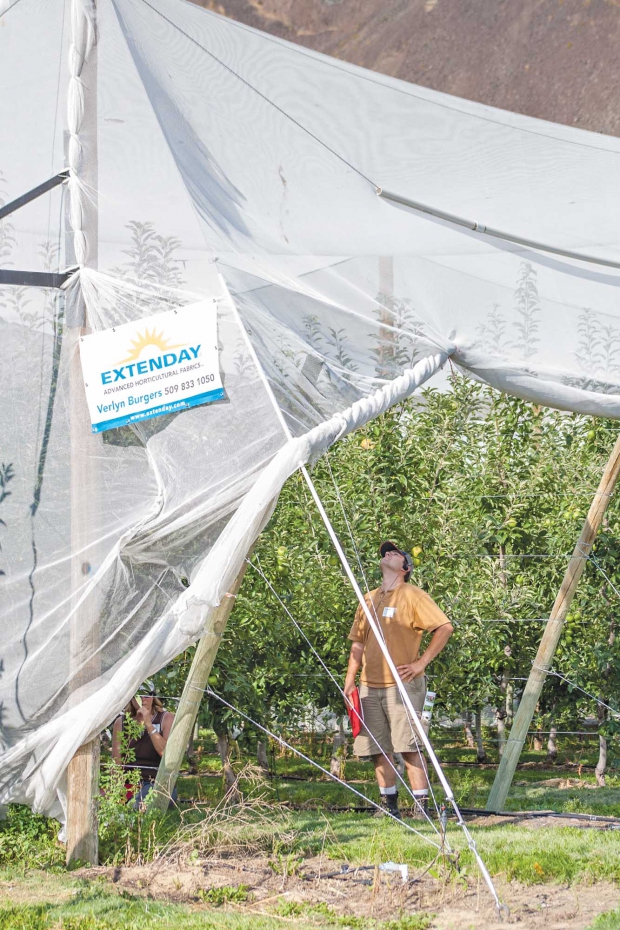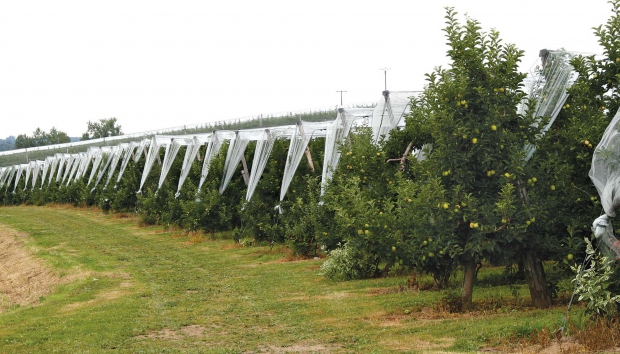
Ty Snyder, of C&O Nursery, examines a protective covering during a field day last summer at Washington State University’s research orchard near Wenatchee. (TJ Mullinax/Good Fruit Grower)
Around the world, tree fruit growers are using covers to protect high-value crops.
Orchardists in the United States have been slow to adopt the practice, but using them could increase returns on investment, says a Washington State tree fruit researcher.
It’s commonplace to see netting and protective covers in orchards in Italy and France, where hail occurs often.
In Australia, growers use covers mainly to protect from bird damage, while in New Zealand, covers block hail.
South African orchardists, who have found significant reduction in sunburn and an increase in yield from covers, are rapidly adopting netting technology and have initiated extensive research trials, according to Tory Schmidt, research scientist with the Washington Tree Fruit Research Commission.
“Growers are using protective covers all over the world,” Schmidt said. “But here in Washington, we don’t have a lot of commercial use or experience with them.”
A panel of horticulturists and netting suppliers from several continents discussed the advantages and drawbacks of protective covers during the Washington State Horticultural Association’s annual meeting.
A common theme was the need to match netting material to the desired effect. Different goals require different netting materials and infrastructure. Additionally, a sturdy infrastructure supporting the orchard cover will determine its success.
The Research Commission initiated a netting trial a few years ago at the Washington State University Sunrise Research Orchard near Wenatchee to learn more about netting under Washington conditions. Schmidt shared that he studied “pods” of netting versus netting draped over Granny Smith apple tree rows. The pods are snug on all sides and cover three tree rows at a time.
Preliminary data showed that there was far less sunburned fruit under the pod netting (control had 59 percent sunburn, pod was 16 percent). Forty-two percent of the fruit was sunburned under drape netting compared with 64 percent in the control.
Fruit was heavier under the pod netting (194 grams compared to 182 grams in the control), but not statistically different in the drape netting trial. Shoot extension was longer in the pod and drape trials than in the control. Fruit set and yield efficiencies were slightly less in the pods than the control.
A hailstorm on August 6 caused minimal (5 percent) damage in the netted Granny Smith fruit but 80 percent damage in the trial’s uncovered fruit.
Dr. Ines Hanrahan, research scientist with the commission, is conducting similar netting trials in Gleed and Zillah, where she is drape netting individual rows of Honeycrisp. Thus far, nets at both sites have significantly reduced the amount and severity of sunburn.
Dr. Stefano Musacchi, WSU’s new pomologist from Italy, said hail is a major problem in Italy, occurring five to six times a year in some locations, and is the primary reason for netting. But Italian growers are finding other advantages, including reduced sunburn, nutrient leaching, and disease incidence, and less need for tree cooling.
While in Italy, he saw less fireblight in netted pears because the trees were not subjected to physical damage from hail. In some regions of the country, growers are completely enclosing the nets as a physical barrier for insects like codling moth.
“The main drawback to netting is the high cost of establishment,” Musacchi said, adding that it also can be difficult to find companies with expertise to install good infrastructures. “Heavy snow loads can compromise the structure, so it’s important to close the nets for the winter. Other drawbacks are a potential reduction in yield and fruit size, due to lower light, and the issue of replanting under an existing structure.”
In Italy, concrete posts and heavy gauge wire (12- to 16-gauge) are used. Netting structures are usually installed before trees are planted. Corner posts used to anchor the support system are a key part of the structure.
In recent years, Italian scientists have begun studying the physiological effects on trees from using blue, red, gray, pearl, yellow, white, or green hail and shade nets (see “Italians study light and shading,” March 15, 2011, Good Fruit Grower).
Bird damage
In Australia, bird damage is the main reason that growers net, said Craig Hornblow, researcher with Ag First New Zealand. “Growers can lose ten to fifteen bins per acre from bird damage.”
But hail is the main reason that New Zealand orchardists use nets, he added. New Zealand growers have discovered other benefits from netting, such as reduced sunburn and russetting, and significantly reduced water use.
Growers use about 20 percent less water under netted structures, Hornblow said.
Because of the expense of netting, many growers have resorted to draping the net over individual orchard rows, using a machine to roll out the net, instead of installing a permanent structure.
Hornblow said that some growers report improved spray coverage and say they can spray for longer periods of time because wind speed is reduced inside the covers. Orchard covers reduce bee activity but increase tree vigor.
Most growers do chemical thinning on the edges or boundaries of the netted orchard, but very little inside.
Costs
Schmidt said that South Africa has some of the most expensive orchard covers, costing about $15,000 per acre.
Orchard covers in Italy cost around $9,800 dollars per acre, not including labor to install the infrastructure.
“I think we can do it for less here in Washington than in Italy,” he said. “We have to not think what the costs are but what the benefits are. We’re pouring a lot of money into our crops, and we need to think about what is the return on investment for our high-value crops.”
Schmidt added that based on the popularity of netting in Italy and South Africa, it appears to make economic sense. “It should also make sense in Washington, especially if it can be done for less money.” •

Hail nets are closed in this Merano, Italy, apple orchard. (Melissa Hansen/Good Fruit Grower)






Leave A Comment